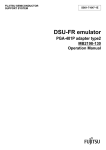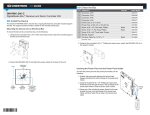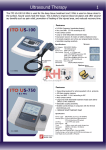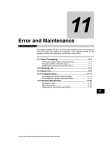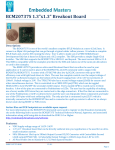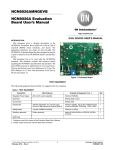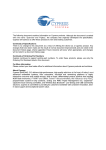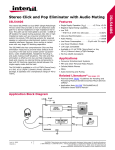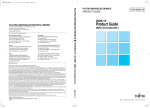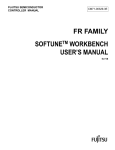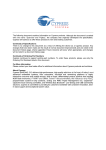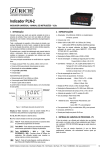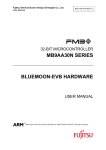Download Manual - Spansion
Transcript
The following document contains information on Cypress products. FUJITSU MICROELECTRONICS SUPPORT SYSTEM SS01-71109-1E DSU-FR EMULATOR PGA-401P ADAPTER TYPE 2 MB2198-130-E OPERATION MANUAL PREFACE Thank you for purchasing the DSU-FR emulator PGA-401P adapter type 2 (MB2198-130-E). The MB2198-130-E is a development support tool for performing evaluations of application products that use a FUJITSU MICROELECTRONICS FR family microcontroller*. This document is for engineers developing FUJITSU MICROELECTRONICS FR family microcontroller application products using the MB2198-130-E (referred to as the “adapter” in this manual), and describes the functionality and handling of the adapter and the configuration methods. Read this manual thoroughly before using the adapter. * : FR, the abbreviation of FUJITSU RISC controller, is a line of products of FUJITSU MICROELECTRONICS LIMITED. ■ Using the product safely This document contains important information for using this product safely. Be sure to read this manual before using the adapter, and to follow the directions given in this manual in order to use the product correctly. In particular, thoroughly read the "■ Caution of the product described in this manual" at the start of this document and section "7. Cautions", and perform a thorough safety check before using the product. Store this document in a safe location where it can easily be accessed at any time while you are using the product. ■ Warranty and liability disclaimers The specifications of the product are subject to change without notice. FUJITSU MICROELECTRONICS assumes no liability for any loss or damage whatsoever directly or indirectly arising out of the use of the product. ■ Product operating environment Use the product at an operating temperature of between +5 °C and +35 °C and at an operating humidity of between 20% to 80%. Avoid using it in a hot or humid environment and prevent condensation. The product is a frameless PC board unit with all electronic components exposed. Therefore, do not put anything on the product, do not touch or let an electrically charged material contact a metal part of it. Once the product has been powered, try to keep those objects away from it which may shortcircuit it or easily catch fire and burn. Use the product as horizontal as possible and avoid operating it at a place exposed to strong vibration, dust, or explosive gas. Note that using the product not in the above operating environment may unexpectedly cause personal injury to the user (or another person if present near the product) or physical damage to properties around the product. You should also keep the packaging materials used for shipping the product. They work well as they are when you transport the product again, for example, if it becomes out of order and needs to be repaired. ■ Related manuals You should refer to the following manuals as well: • Evaluation MCU hardware manual or datasheet • Header operation manual • DSU-FR EMULATOR MB2198-01-E OPERATION MANUAL • SOFTUNE Workbench OPERATION MANUAL • SOFTUNE Workbench USER’S MANUAL ■ European RoHS compliance Products with a -E suffix on the part number are European RoHS compliant products. ■ Notice on this document All information included in this document is current as of the date it is issued. Such information is subject to change without any prior notice. Please confirm the latest relevant information with the sales representatives. i ■ Caution of the product described in this manual The following precautions apply to the product described in this manual. WARNING Indicates a potentially hazardous situation which could result in death or serious injury and/or a fault in the user’s system if the product is not used correctly. Electric shock, Damage Before performing any operation described in this manual, turn off all the power supplies to the system. Performing such an operation with the power on may cause an electric shock or device fault. Electric shock, Damage Once the product has been turned on, do not touch any metal part of it. Doing so may cause an electric shock or device fault. CAUTION Cuts, Damage Cuts Damage Damage Damage Damage Damage Damage Damage Damage Indicates the presence of a hazard that may cause a minor or moderate injury, damages to this product or devices connected to it, or may cause to loose software resources and other properties such as data, if the device is not used appropriately. Before moving the product, be sure to turn off all the power supplies and unplug the cables. Watch your step when carrying the product. Do not use the product in an unstable location such as a place exposed to strong vibration or a sloping surface. Doing so may cause the product to fall, resulting in an injury or fault. The product contains sharp edges that are left unavoidably exposed, such as jumper plugs. Handle the product with due care not to get injured with such pointed parts. Do not place anything on the product or expose the product to physical shocks. Do not carry the product after the power has been turned on. Doing so may cause a malfunction due to overloading or shock. Since the product contains many electronic components, keep it away from direct sunlight, high temperature, and high humidity to prevent condensation. Do not use or store the product where it is exposed to much dust or a strong magnetic or electric field for an extended period of time. Inappropriate operating or storage environments may cause a fault. Use the product within the ranges given in the specifications. Operation over the specified ranges may cause a fault. To prevent electrostatic breakdown, do not let your finger or other object come into contact with the metal parts of any of the connectors. Before handling the product, touch a metal object (such as a door knob) to discharge any static electricity from your body. When turning the power on or off, follow the relevant procedure as described in this document. Before turning the power on, in particular, be sure to finish making all the required connections. Furthermore, be sure to configure and use the product by following the instructions given in this document. Using the product incorrectly or inappropriately may cause a fault. Always turn the power off before connecting or disconnecting any cables from the product. When unplugging a cable, unplug the cable by holding the connector part without pulling on the cable itself. Pulling the cable itself or bending it may expose or disconnect the cable core, resulting in a fault. Because the structure of the MCU socket does not allow an evaluation MCU to be mounted in the incorrect orientation, be very careful of the orientation of the evaluation MCU when mounting it. Inserting the evaluation MCU in the wrong orientation may damage the MCU, causing the MCU to become faulty. Because the product has no casing, it is recommended that it be stored in the original packaging. Transporting the product may cause a damage or fault. Therefore, keep the packaging materials and use them when re-shipping the product. ii • The contents of this document are subject to change without notice. Customers are advised to consult with sales representatives before ordering. • The information, such as descriptions of function and application circuit examples, in this document are presented solely for the purpose of reference to show examples of operations and uses of FUJITSU MICROELECTRONICS semiconductor device; FUJITSU MICROELECTRONICS does not warrant proper operation of the device with respect to use based on such information. When you develop equipment incorporating the device based on such information, you must assume any responsibility arising out of such use of the information. FUJITSU MICROELECTRONICS assumes no liability for any damages whatsoever arising out of the use of the information. • Any information in this document, including descriptions of function and schematic diagrams, shall not be construed as license of the use or exercise of any intellectual property right, such as patent right or copyright, or any other right of FUJITSU MICROELECTRONICS or any third party or does FUJITSU MICROELECTRONICS warrant non-infringement of any third-party's intellectual property right or other right by using such information. FUJITSU MICROELECTRONICS assumes no liability for any infringement of the intellectual property rights or other rights of third parties which would result from the use of information contained herein. • The products described in this document are designed, developed and manufactured as contemplated for general use, including without limitation, ordinary industrial use, general office use, personal use, and household use, but are not designed, developed and manufactured as contemplated (1) for use accompanying fatal risks or dangers that, unless extremely high safety is secured, could have a serious effect to the public, and could lead directly to death, personal injury, severe physical damage or other loss (i.e., nuclear reaction control in nuclear facility, aircraft flight control, air traffic control, mass transport control, medical life support system, missile launch control in weapon system), or (2) for use requiring extremely high reliability (i.e., submersible repeater and artificial satellite). Please note that FUJITSU MICROELECTRONICS will not be liable against you and/or any third party for any claims or damages arising in connection with above-mentioned uses of the products. • Any semiconductor devices have an inherent chance of failure. You must protect against injury, damage or loss from such failures by incorporating safety design measures into your facility and equipment such as redundancy, fire protection, and prevention of over-current levels and other abnormal operating conditions. • Exportation/release of any products described in this document may require necessary procedures in accordance with the regulations of the Foreign Exchange and Foreign Trade Control Law of Japan and/or US export control laws. • The company names and brand names herein are the trademarks or registered trademarks of their respective owners. Copyright © 2008 FUJITSU MICROELECTRONICS LIMITED All rights reserved iii 1. Overview This product is a development support tool for developing and evaluating hardware and software that uses the FUJITSU MICROELECTRONICS FR family microcontroller. ■ Overview It is used with the DSU-FR emulator header*1 to connect the user system corresponding to the FUJITSU MICROELECTRONICS FR family microcontroller and the DSU-FR emulator (MB219801-E)*2. *1 : Referred to as the “header” in this document. *2 : Referred to as the “emulator” in this document. The main features of this product are as follows. • The adapter consists of an adapter board and flat cables (2 sets of the Standard and Long types). • The adapter board has an on-board IC socket for evaluation MCU (401-pin PGA package code: PGA-401C-A02). • Connected to the header using a flat cable (standard or long one) • Used in combination with the header to connect the emulator and the user system • Power to the adapter is supplied from the user system via the emulator or header. • Supports the internal ROM emulation memory function. • Supports the external memory emulation function. • Supports the external trace function. • Supports the power-on debug function. ■ Checking the items packaged Check that the package contains all of the following items before using the product. • Adapter board: 1 • Flat cables (Standard: 8cm): 2 • Flat cables (Long: 20cm): 2 • Operation manual (Japanese version): 1 • Operation manual (English version: this document): Note : Transporting the product may cause a damage or fault. Therefore, keep the packaging materials and use them when re-shipping the product. 1 ■ Optional parts The optional parts for this product are shown in Table 1. Purchase them as required. Table 1 Optional parts Name Part number Evaluation MCU FUJITSU MICROELECTRONICS FR family microcontroller (MB91Vxxx)*1 DSU-FR emulator MB2198-01-E*2 DSU-FR emulator header MB2198-XXX-E*3 DSU-FR emulator memory board*4 − Oscillator*5, Capacitor*5 − *1 : The package code of the evaluation MCU is PGA-401C-A02. If you do not know the type and package code of the evaluation MCU that can be used for this product, contact the sales or support representative. *2 : Debugger software and communications cables need to be purchased in order to use the emulator. If you are unsure of the details, contact the sales or support representative. *3 : The header is an interface board used to connect the user system to the emulator. Select and purchase the suitable header for the mass production MCU to be used. See the header operation manual for handling and using headers and precautions of safe use. *4 : The memory board is required to use the external-memory emulation function (under planning). *5 : See the data sheet of evaluation MCU for details on the frequency of the oscillator to use. Furthermore, see the data sheet of the oscillator for details on the values of the capacitors to connect to the oscillator. 2 2. System Configuration Used in combination with the header, the adapter is connected to the emulator and the user system. ■ System configuration Figure 1 shows the system configuration for the adapter. Host computer General-purpose measuring instrument AC in External trigger / program execution RS232C, USB, LAN AC adapter* Fujitsu Emulator Loader Mode Now. DSU-FR emulator Evaluation MCU Adapter board Adapter (this product) Flat cable Header board Header User system * : The AC adapter is bundled with the emulator. Figure 1 System configuration diagram See the operation manual of the emulator for details on connecting the emulator to the host computer and general-purpose measuring instrument. In order to use the emulator, a host computer and emulator debugging software need to be purchased separately. See the operation manual of the emulator for the emulator specifications. 3 ■ Appearance and part names Figure 2 gives an external view of the adapter board to identify each part of it. The adapter board illustrated in Figure 2 is in the factory default states. (1) (2) (3) A EML S9 VSEL4 (9) USR C S8 VSEL3 B − SW2 EML S7 VSEL2 USR SW4 A8 A9 A10 A11 A12 A13 A14 A15 A16 A17 A18 A19 A20 A21 SW3 1 2 3 4 5 6 7 8 − ON 1 2 3 4 5 6 7 8 ON S6 VSEL1 USR + + ON 1 2 3 4 5 6 7 8 RD A1 A2 A3 A4 A5 A6 A7 C7(SC8,9) ON 1 2 3 4 1 2 3 + SW1 (8) EML S5 SC2 ASEL − C6(SC6,7) + C2(SC4,5) EML S4 − EML USR INIT TRST EML USR (5) C11(SC10,11) M2(SC1) (4) SC3 X0A/X1A X0A USR X1A CN5 X0/X1 (6) X0 USR X1 (10) (7) Figure 2 External view 4 (1) Emulator connector This connector accepts the emulator (Mounted on the rear side). (2) IC socket for evaluation MCU 401-pin PGA IC socket for mounting an evaluation MCU (3) Memory size selection switch This switch sets the capacity of the memory board to use external-memory emulation. (4) DVCC bypass capacitor sockets These sockets accept bypass capacitors to be inserted between DVCC and GND pins. (5) Reset signal setting jumper plugs These jumper plugs are used to set the reset signal supply source. (6) Memory board connector This connector accepts a memory board (for external-memory emulation). (7) Flat cable connectors Use the flat cable packaged in this product, and connect to the header or user system. (8) Memory connection switches If the external memory emulation function is being used, these switches connect the I/O ports of the evaluation MCU to the external memory emulation lines. (9) Jumper plugs for setting the evaluation MCU power supply These jumper plugs are used to make settings for the evaluation MCU. (10) Clock input IC sockets and clock input select jumper plugs The IC sockets accept an oscillator and a capacitor for the main clock and sub clock; the jumper plugs are used to set the clock supply source. 5 3. Specifications ■ General specifications Table 2 lists the general specifications of the adapter. Table 2 General specifications Item Specification Name DSU-FR emulator PGA-401P adapter type 2 Part number MB2198-130-E Power supplies Evaluation MCU: Internal power supply* 0 V to +5.5 V (UVcc) Evaluation MCU: I/O power supply* 0 V to +5.5 V (UVcc) Adapter board power supply +3.3 V (Supplied from emulator) Internal operating frequency of MCU Max: 34MHz Temperature Operation: 5 °C to 35 °C Storage: 0 °C to 70 °C Humidity Operation: 20% to 80% (No condensation) Storage: 20% to 80% (No condensation) External dimensions (W) 205mm × (D) 110mm × (H) 30mm (Including the IC socket and connector dimensions) Weight 173g * : For details on the internal power supply and I/O power supply of each evaluation MCU, see the power supply specifications of the evaluation MCU. For details on each of the power supplies, see the "Evaluation MCU hardware manual" or contact the sales or support representative if you are unsure. Note : Operating the device outside the range of any general specification may cause the device to malfunction. Use the device in the ranges of its general specifications. 6 ■ Function specifications Table 3 lists the major function specifications of the adapter. Table 3 Adapter function specifications Item Description Adapter function Used in combination with the DSU-FR emulator and header, it functions as the adapter for connecting the emulator to the evaluation MCU and user system. External trace memory Supports the external trace function. Trace length of 64K frames. Internal ROM emulation Supports the internal ROM emulation memory function. 1Mbyte max. Supports the external memory emulation*1 function. Can be configured as RAM or ROM, and the memory capacity is selectable. This function is implemented by mounting an optional memory board on the adapter board. The capacity of the memory board can be selected from Memory capacity select among seven steps between 2M words and 32K words (1 word = 16 bits). External memory emulation Memory connection Address lines that are disabled by the memory capacity selection function are able to be disconnected from the buffers and used as user resources instead. Furthermore, even when the external memory emulation function is not being used, the load associated with using the address lines as user resources can be reduced by disconnecting the lines. Power-on debugging Supports the power-on debug function*2 which runs a program immediately after the power-on sequence of the evaluation MCU. Jumper plugs The jumper plugs on the adapter board can be used to make various settings of the adapter. Clock input IC sockets The adapter has IC sockets for using oscillators to supply clock signals from the adapter to the main clock (X0/X1) and sub clock (X0A/X1A) pins of the evaluation MCU. *1 : The evaluation MCU must support the external-memory emulation feature. The total amount of memory available depends on the memory capacity of the memory board, the memory capacity selection switches, and the settings of the evaluation MCU. Before using this function, see the “Evaluation MCU hardware manual” or contact the sales or support representative if you are unsure. For details, see Section 6.4 "Setting the External Memory Emulation" Note also that this function is added to the external bus of the evaluation MCU. Before using the function, read “7. Cautions” carefully. *2 : This function assumes that the evaluation MCU supports the power-on debug feature. Before using the function, see the “Evaluation MCU hardware manual” or contact the sales or support representative if you are unsure. 7 ■ Connector and socket specifications Table 4 lists the specifications of the connectors and IC sockets mounted on the adapter board. Table 4 Connector and IC socket specifications Item Description Emulator connector Use this connector to connect the emulator to the adapter. For connecting the emulator, see Section 4 "Connection ■ Connecting the adapter board to the emulator". Flat cable connectors Connect the adapter to the header using flat cables coming with the adapter. For connecting the flat cable, see Section 4 "Connection ■ Connecting the adapter board to the header board". Evaluation MCU mounting IC socket Mount the evaluation MCU (PGA-401P package). For mounting the evaluation MCU, see Section 5.1 "Installing the Evaluation MCU". Memory board connector Mount an optional memory board. For mounting the memory board, see Section 5.2 "Installing the Memory Board". Oscillator IC sockets Mount an oscillator and a capacitor authorized for the oscillator. For mounting the oscillator and capacitor, see Section 6.2 "Setting the Clock Supply Circuit". If the evaluation MCU has an integrated digital power supply (such as a DVCC power supply), a bypass capacitor can be DVCC bypass capacitor mounting mounted on the digital power supply as required. sockets For mounting the bypass capacitor, see Section 5.3 "Installing a Bypass Capacitor for DVCC". 8 4. Connection ■ Connecting the adapter board to the emulator Connect the adapter board to the adapter board connector on the emulator as shown in Figure 3. Adapter board Emulator connector Index Adapter board connector Emulator • Insert the connector for connecting the emulator to the adapter board securely to the far end, and align the index (▲) on each connector for prevention of incorrect insertion. • Apply even force to the connector for removing the adaptor board from the emulator. Figure 3 Connecting the adapter board to the emulator Note : Turn power off before board setting/removal. Apply even force to the connector for unplugging the board. 9 ■ Connecting the adapter board to the header board Connect the adapter board to the header board using the flat cables that are provided with the adapter, as shown in Figure 4. Adapter board Flat cable connector A Flat cable connector B Eject lock Flat cable Eject lock Flat cable connector A Flat cable connector B Header board • Insert the eject lock units into the flat cable connectors on each of the boards until locked. • Disconnect the flat cables by pulling out the eject locks of the flat cables and releasing the locks. • To connect the adapter board and the user system directly, mount the specified connector on the user system confirming Item 8. “User Interface”. Figure 4 Connecting the adapter board with the header board Note : Before plugging or unplugging the cable, turn off the power supply. When unplugging the cable, remove it while holding the case connector without pulling the cable itself. 10 5. Installation 5.1 Installing the Evaluation MCU Install the evaluation MCU on the evaluation MCU mounting IC socket on the adapter board as illustrated in Figure 5 to Figure 7. To uninstall the evaluation MCU, follow the instruction illustrated in Figure 8. ■ Installing the evaluation MCU Open the lever of the evaluation MCU mounting IC socket (SC1) to from the dotted-line position to the solid-line position. Evaluation MCU Evaluation MCU mounting IC socket Figure 5 Installing the evaluation MCU ■ Mounting position Align pin No. 1 of the evaluation MCU with its pin hole in the evaluation MCU mounting IC socket (SC1) and insert the evaluation MCU horizontally (check by looking from the above angle). Evaluation MCU M2(SC1) No. 1 pin Evaluation MCU mounting IC socket Figure 6 Mounting position 11 ■ Securing the evaluation MCU Close the lever of the evaluation MCU mounting IC socket (SC1) from the dotted-line position to the solid-line position to lock the evaluation MCU. Evaluation MCU Evaluation MCU mounting IC socket Figure 7 Securing the evaluation MCU ■ Removing the evaluation MCU To removing the evaluation MCU, open the lever of the evaluation MCU mounting IC socket (SC1) from the dotted-line position to the solid-line position, then remove the evaluation MCU. Evaluation MCU Evaluation MCU mounting IC socket Figure 8 Removing the evaluation MCU 12 5.2 Installing the Memory Board When using the external memory emulation function, install an optional memory board into the memory board connector on the adapter board as illustrated in Figure 9 to Figure 11. To uninstall the memory board, follow the instruction illustrated in Figure 12. ■ Mounting position Align the notch on the memory board with the key of the memory board connector. Memory board Clips Memory board connector CN5 Align these parts Figure 9 Mounting position ■ Inserting the memory board Insert the memory board into the memory board connector at an angle as shown in Figure 10 (check by looking from the side). Memory board Memory board connector Figure 10 Inserting the memory board 13 ■ Securing the memory board Put the memory board down from the dotted-line position to the solid-line position and hold the memory board between the clips on both sides until it clicks into place to lock it. Memory board Memory board connector Figure 11 Securing the memory board ■ Removing the memory board To remove the memory board, open the clips on both sides of the memory board connector by pushing them outward (as shown in the left-side sketch in Figure 12). Pull the memory board up from the dotted-line position to the solid-line position to remove it (as shown in the right-side sketch in Figure 12). Memory board Clips Memory board connector CN5 Memory board Memory board connector Figure 12 Removing the memory board 14 5.3 Installing a Bypass Capacitor for DVCC If the evaluation MCU has an integrated digital power supply (DVCC pin), a bypass capacitor can be mounted on the digital power supply as required.When it does not have a digital power supply (DVCC pin) in Evaluation MCU, a bypass capacitor does not need to be mounted. ■ Installing a bypass capacitor To use a polarized capacitor such as an electrolytic capacitor as the bypass capacitor, install it according to the polarity defined by the silk pattern on the PC board. Use meticulous care to check the polarity. Select the appropriate capacitor so that its type, capacitance, and withstand voltage are best suited for the operating environment. Figure 13 shows how to install the capacitor. Table 5 lists the signal names of digital power supply pins of the evaluation MCU plugged in each capacitor mounting socket. Capacitor (The longer pin is positive) Index ( − ) 16V 10 It is cautious of the polarity of a capacitor! Socket for mounting capactors − + Figure 13 Mounting the capacitor Table 5 The signal names of digital power supply pins of the evaluation MCU Capacitor mounting socket name Correspondence signal line Evaluation MCU pin number SC4, SC5 PF2 127 SC6, SC7 PD3 241 SC8, SC9 P85 36 SC10, SC11 P65 39 15 6. Setting Procedures 6.1 Setting up the Evaluation MCU Power Supply Figure 14 shows the power supply circuit configuration of evaluation MCU, Figure 15 shows the factory settings of the jumper plugs of evaluation MCU power supply, and Table 6 shows the evaluation MCU power supply specifications according to the settings of each jumper plug from VSEL1 to VSEL4. ■ Power supply circuit configuration of evaluation MCU Adapter Board Emulators connector User System (Board) +3.3V MCU mounting part Flat cable connector (MCU mounting part) VSEL1 Dedicated power supply of emulator Evaluation MCU Internal power supply EML USER VSEL2 USER Capacitor 0.1uF C Internal MCU power supply GND VSEL3 Main clock power supply I/O power-supply A MCU I/O power-supply B VSEL4 External memory emulation part EML USER Figure 14 Evaluation MCU power supply circuit configuration ■ Settings of evaluation MCU power supply setup jumper plugs (VSEL1 to VSEL4) VSEL1 USR EML VSEL2 USR C VSEL3 B A VSEL4 USR EML Figure 15 Settings of evaluation MCU power supply setup jumper plugs (factory settings) 16 Table 6 Jumper plug settings Jumper plug name Setting Evaluation MCU power supply specifications USR side Supplies from the user system the dedicated power supply for emulator. EML side Supplies the dedicated power supply for the emulator*1 from the emulator. USR side Supplies the user system power supply to the internal power supply of evaluation MCU. C side Adds the capacitor (0.1µF) to the internal power supply of the evaluation MCU*2. A side Supplies the main clock power supply*3 from the internal power supply of evaluation MCU. B side Supplies the main clock power supply*3 from the I/O power supply of evaluation MCU (B side fixed). USR side Supplies the back-up power supply*4 from the user system (evaluation MCU I/O power supply) using as RAM. EML side Supplies from the emulator the back-up power supply*4 , using as ROM. Always use this setting when the external memory emulation function is not being used. VSEL1 VSEL2 VSEL3 VSEL4 *1 : When using a power-on debugging function, it is necessary that the dedicated power supply for emulator should be supplied from an emulator (EML side), and the evaluation MCU should support the power-on debugging function. See the "Evaluation MCU hardware manual" or "datasheet", for information whether the evaluation MCU supports power-on debbugging function. Contact the sales or support representative if you are unsure. *2 : For the specifications of the internal power supply of evaluation MCU, see the “Evaluation MCU hardware manual” or contact the sales or support representative if you are unsure. *3 : Supply the I/O power supply of evaluation MCU to the main clock power supply. *4 : The backup power supply is used for the external-memory emulation circuit on the adapter board.To use the data backup function, supply backup power from the emulator. In this case, the emulator detects the power-on or shutdown state of the user system to back up data on the adapter board (ROM equivalent operation). 17 6.2 Setting the Clock Supply Circuit The clock peripheral circuit configuration to the evaluation MCU are shown in Figure 16, the installing method of oscillator in Figure 17, the factory default setting of clock selection jumper plug in Figure 18, and the correspondence between clock selection jumper plug and clock supply in Table 7. ■ Clock peripheral circuit configuration User system (Board) Adapter Board USR X1 EML X1 X1 USR X0 EML X0 X0 X0/X1 1 2 3 4 Evaluation MCU 8 7 6 5 GND GND USR X1A EML X1A/PF6 X1A USR X0A EML Flat cable connector X0A/PF5 X0A X0A/X1A 1 2 3 4 8 7 6 5 GND GND Figure 16 Clock peripheral circuit configuration of evaluation MCU ■ Installing the oscillator Mount the oscillators and capacitors on the oscillator IC sockets (SC2, SC3) of the adapter board to supply the clock signal from the adapter board to the main clock (X0/X1) and to sub clock (X0A/ X1A) of the evaluation MCU respectively. Oscillator Install the capacitor across pins 2 and 4 or across pins 3 and 4. Install the capacitor across pins 5 and 6 or across pins 5 and 7. Capacitor Capacitor • See the data sheet of the evaluation MCU for the oscillator frequency and other details. • See the oscillator data sheet for details on the capacitor's capacitance. • The oscillator and capacitors are not provided with this product and need to be purchased separately. Figure 17 Installing the oscillator 18 Note : For a cpacitor that is mounted with the oscillator, use a capacitor about 10pF smaller than the recommended value of the oscillator. When a capacitor of the recommended value of the oscillator is mounted, an oscillator stabilization time becomes longer than the standard time due to the parasitic capacitance of a socket and the influence of an interconnect load and that may cause a failure such as instability of clock switching operation etc. ■ Clock selection jumper plugs The factory settings of the jumper plugs are shown in Figure 18, and the correspondence between the clock selection jumper plugs and clock supply is shown in Table 7. X0 USR X1 EML X0/X1 X0A USR X1A EML X0A/X1A Figure 18 Setting the clock selection jumper plugs (factory setting) Table 7 Jumper plug settings Jumper plug name Setting Clock supply* USR side Supply main clock signal from user system. EML side Supply main clock signal from oscillator IC socket on adapter. EML side Supply sub clock signal from oscillator IC socket on adapter (fixed on EML side). X0,X1 X0A,X1A * : There is no function to supply a clock signal from the adapter to the user system. Note : To supply the main clock from the user system, create the oscillation circuit on the user system, buffer the main clock via the CMOS buffer or the like, and then supply it. Since supplying the sub clock from the user system may result in instable operation, be sure to supply the sub clock from the adapter board. 19 6.3 Setting the Reset Signal Supply the reset signals to the evaluation MCU by the user system and the emulator. Use the jumper plugs with the factory default settings. ■ Setting the reset signal The factory default settings of the reset signal selection jumper plugs are shown in Figure 19. Under the factory default settings, the INITX signal (INIT) is supplied to the evaluation MCU from the INITX signal on the user system via the emulator, and the TRSTX signal (TRST) is supplied to the evaluation MCU from the reset signal of the emulator. INIT USR EML USR EML TRST Figure 19 Setting the reset signal setting jumper plugs (factory setting) 6.4 Setting the External Memory Emulation The external memory emulation block diagram is shown in Figure 20, the settings of the switch are shown in Figure 21 and the memory board sizes and valid addresses selected by the switches are shown in Table 8, the factory settings of the memory connection switches are shown in Figure 22, and the individual switches in each memory connection switch block and the corresponding signal lines and evaluation MCU pin numbers are shown in Table 9. ■ External memory emulation block diagram Data bus Evaluation MCU P1[7:0],P0[7:0] Memory connection 74LVCH16244A switch Externalmemory emulation circuit Y Flat cable connector Address bus P4[5:0],P3[7:0],P2[7:1],P5[4] A *OE GND Adapter board Figure 20 External memory emulation block diagram 20 To header ■ Setting the memory size selection switch The memory size selection switch select the size of the memory board to be connected when the external memory emulation function is being used. ASEL ON 1 2 3 4 1 2 3 SW1 Figure 21 Setting the memory size selection switch (factory default settings) Table 8 The memory size selection switch settings ASEL3 ASEL2 ASEL1 Memory board size Valid addresses 1 1 1 1 1 0 2 MWords A[21:1] 1 0 1 1 MWords A[20:1] 1 0 0 512 KWords A[19:1] 0 1 1 256 KWords A[18:1] 0 1 0 128 KWords A[17:1] 0 0 1 64 KWords A[16:1] 0 0 0 32 KWords A[15:1] ■ Setting the memory connection switches When the external memory emulation function is used, the address lines that are disabled by the memory size selection setting can be disconnected from the buffers and used as user resources instead. Even when the external-memory emulation function is not used, the switches can be used to disconnect those address lines from buffers to reduce the load on the address lines used as user resources. The factory default settings of the switches are shown in Figure 22 and the individual switches in each switch block and the corresponding signal lines and evaluation MCU pin numbers are shown in Table 9. SW2 RD A1 A2 A3 A4 A5 A6 A7 1 2 3 4 5 6 7 8 ON A8 A9 A10 A11 A12 A13 A14 A15 1 2 3 4 5 6 7 8 ON SW3 A16 A17 A18 A19 A20 A21 1 2 3 4 5 6 7 8 ON SW4 Figure 22 Setting the memory connection switches (factory default settings) 21 Table 9 The memory connection switch settings Part number (Printed on board) SW2 SW3 SW4 Element number (Labeled on switch) 1 2 3 4 5 6 7 8 1 2 3 4 5 6 7 8 1 2 3 4 5 6 Corresponding signal line* P54 (RDX) P21 (A1) P22 (A2) P23 (A3) P24 (A4) P25 (A5) P26 (A6) P27 (A7) P30 (A8) P31 (A9) P32 (A10) P33 (A11) P34 (A12) P35 (A13) P36 (A14) P37 (A15) P40 (A16) P41 (A17) P42 (A18) P43 (A19) P44 (A20) P45 (A21) Evaluation MCU’s pin number* 140 310 201 357 257 144 309 256 200 356 308 92 44 255 143 199 307 91 142 254 43 198 * : The user resources corresponding to the above pin numbers are different depending on the evaluation MCU used. For details, see the hardware manual for the evaluation MCU to be used or “8. User Interface”. 22 6.5 Power-on/Shutdown Procedures Turn the power on after completing all of the connections in the sequence: host computer → emulator → user system. Turn the power off in the sequence: user system → emulator → host computer. ■ Power-on procedure Turn the power on using the sequence shown in Figure 23 after completing all of the connections. The emulator power is turned on by pressing the power switch on the rear of the emulator. The power switch remains depressed when pressed. See the operation manual of the emulator for details on the position of the power switch. Turn on the power to the host computer Turn on the power to the emulator POWER LED lights up Run "SOFTUNE Workbench" Run "Emulator Debugger" Check that the dialog box (see Figure 24) Turn on the power supply to the user system Click "OK" on the dialog box (see Figure 24) Figure 23 Power-on procedure Figure 24 Dialog box 23 ■ Power-off procedure Turn the power off using the sequence shown in Figure 25. Turn off the power supply to the emulator by pressing the switch on the rear of the emulator and releasing your finger. The switch then returns to the off state with the switch protruding. See the operation manual of the emulator for details on the position of the power switch. Exit "Emulator Debugger" Turn off the power supply to the user system Turn off the power supply to the emulator Turn off the host computer (as required) Figure 25 Shutdown procedure 24 7. Cautions ■ General cautions on the adapter • Disconnect all of the power supplies from the adapter, emulator, and user system before setting any jumper plugs or switches on the adapter board. • The settings of jumper plugs VSEL1 to VSEL4 are related to the power supply. Setting these jumper plugs incorrectly may destroy the entire system. • When a clock signal is supplied ti the evaluation MCU from the user system, the wiring pattern from the clock signal source on the user system side may be too long to provide oscillation. • If it is instructed that the X0 or X1 pin should be opened as restricted to the evaluation MCU when a clock signal is being supplied from the user system to the evaluation MCU using an oscillator, remove the jumper plug for switching the clock signal supply source on the specified side. This is also applicable to X0A/X1A pin. • When using the emulator, set the reset signal jumper plug which selects the control source of the INITX pin of the evaluation MCU to the EML side. When the emulator is being used, the emulator controls the INITX pin of the evaluation MCU, and the reset input from the user system is not connected directly to the evaluation MCU, but is routed via the emulator. The reset timing is therefore delayed by several clock cycles compared to the actual reset timing. Furthermore, when a reset is performed using the emulator reset command, only the evaluation MCU is reset, and the user system is not reset. In addition, the signal to the INITX pin from the user system is masked by the emulator during a break. • The states of the user bus pins when the evaluation MCU is in user hold or low power consumption modes are the same as the states shown in the MCU hardware manual. • The “flat cable (long)” can be used if the MCU’s clock frequency is low or the load of the user pin is very low. Basically, use the “flat cable (standard)”. • If using the adapter and the header, always make sure that the MCU on the user system is socket-mounted to be removed, Use the specified IC socket for the MCU socket. • Power is not supplied from the adapter, header, or emulator to the user system. • When the external memory emulation function is not used, set all the memory connection switches to OFF. If external signals are applied with the memory connection switches set to ON, drive the adapter at a current of at least ±750µA. If the drive current is lower than ±750µA, a normal potential may not be obtained due to the bus hold feature of the buffer IC. 25 ■ Cautions when using the external memory emulation function • When using the external memory emulation function, set the memory connection switches to ON that correspond to the valid address bus signals (equivalent to A[21:1] depending on the memory size settings) and the control lines (equivalent to RDX). • A buffer IC is connected to the valid address bus signals (which vary depending on the memory size setting) and control lines used for external memory emulation. A capacitance of about 6pF is therefore added to each of the signal conductors. • As a buffer IC is connected to the valid address bus signals and control lines used for external memory emulation, each signal conductor connected to the memory board involves a delay of about 6ns. • As the data bus used for external memory emulation is connected directly to the data bus signal (equivalent to D[31:16]), the external I/O power supply to the evaluation MCU must always be within +3.3V. If the external I/O power supply exceeds +3.3V, the memory board may be damaged. • As the data bus used for external-memory emulation is connected directly to the data bus of the evaluation MCU, a capacitance of about 6pF is added to each signal conductor when the memory board is installed. • The data bus used for external-memory emulation is fixed at 16 bits in width. • Although some of the address bus signals, data bus signals, and control lines of the memory board are connected to the user system, the chip select signal is not connected and thus the user system cannot access data in the memory board. ■ Cautions when using the power-on debug function • When performing power-on debugging, pay due attention to the settings related to power supply. • The following three conditions must be satisfied when the power supply is turned off by power-on debugging: 1. It takes 25µs or more for all the power supply levels of the evaluation MCU to decrease from 0.9Vcc to 0.5Vcc. 2. The CPU operating frequency is 1MHz or higher. 3. A user program is being executed. • For details on the power-on debug function, see the emulator operation manual. ■ Cautions when using the external memory emulation function and the power-on debug function If the user power supply is shut off with the external address and RDX pins remaining high level, the bus hold feature of the buffer ICs on the adapter board causes a current of up to 250µA to flow until each signal level goes low. 26 8. User Interface ■ User Interface Specifications The correspondence between the pin numbers of flat cable connectors A and B on the adapter board and those on the header or user system are shown in Figure 26, and the correspondence between the pin numbers of flat cable connectors A and B and the evaluation MCU is shown in Table 10 and Table 11. Note that the evaluation MCU signal names in the table are provisional names and the actual signal names vary with each model. The actual evaluation MCU signal names can be judged from the evaluation MCU pin numbers. If you are unsure of the details, contact the sales or support representative. The following notation and warnings apply to each of the evaluation MCU signal names. • • • • Vcc_A Vcc_B VCCXTL GND : Internal power supply of the evaluation MCU (or the C pin). : I/O power supply of the evaluation MCU (or a single power supply). : Main clock power supply of the evaluation MCU. : Ground of the evaluation MCU. Note : The pins that are identified by the underlined evaluation MCU signal names in the table may have additional circuitry attached for controlling the evaluation MCU. As a result, the electrical characteristics of these pins may differ from an actual MCU. See the sections listed below for details on the additional circuit for each signal. • P65/P85/PD3/PF2 (DVcc) : See Section 5.3 "Installing a Bypass Capacitor for DVCC" • X0/X1 : See Section 6.2 "Setting the Clock Supply Circuit" • X0A/X1A (PF5/PF6) : See Section 6.2 "Setting the Clock Supply Circuit" • P54 (RDX) : See Section 6.4 "Setting the External Memory Emulation" P4[5:0] (A[21:16]) P3[7:0] (A[15:8]) P2[7:1] (A[7:1]) P1[7:0] (D[15:8]) P0[7:0] (D[7:0]) The emulator uses Vcc_A and Vcc_B mainly as the power supplies to the evaluation MCU and additionally for voltage detection purposes only; it does not contain circuit consuming large power. It is recommended to use the “flat cable (standard)” bundled with the emulator to prevent noise trouble. Provide the user system with a connector equivalent to the flat cable connector. The part number of the flat cable connector is as follows: • Flat cable connector part number: 8930E-100-178MS-F (manufactured by KEL) Note that the pinouts of flat cable connectors A and B are different between the adapter board and the user system. 27 Adapter board Header or user system Flat cable connector Flat cable connector CN2 CN1 A B A A50 B50 A50 B50 A1 B1 A1 B1 TOP VIEW (these connectors are mounted on the back surface) B50 B1 B A50 A1 B1 A50 A1 TOP VIEW (these connectors are mounted on the front surface) Figure 26 Pin numbers of flat cable connectors A and B 28 B50 Table 10 Pinouts of flat cable connector A Connector pin number Evaluation MCU signal name (provisional name)* Evaluation MCU pin number Connector pin number Evaluation MCU signal name (provisional name)* Evaluation MCU pin number A1 A2 A3 A4 A5 A6 A7 A8 A9 A10 A11 A12 A13 A14 A15 A16 A17 A18 A19 A20 A21 A22 A23 A24 A25 A26 A27 A28 A29 A30 A31 A32 A33 A34 A35 A36 A37 A38 A39 A40 A41 A42 A43 A44 A45 A46 A47 A48 A49 A50 GND P91 P93 P95 P97 AVRH AVSS PC1 PC3 PC5 PC7 PA0 Vcc_A P87 GND P84 P82 P80 P77 P75 P73 P71 GND VCC3B X0A/PF5 P66 P65 (DVcc) P63 P61 P57 GND P54 (RDX) P52 P51 P50 P46 VCCXTL P21 (A1) GND P24 (A4) P26 (A6) P30 (A8) P32 (A10) P33 (A11) P35 (A13) P37 (A15) P41 (A17) P43 (A19) P45 (A21) GND − 135 301 191 349 296 186 188 244 187 243 83 − 249 − 302 136 37 138 250 195 38 − 5 209 252 39 40 139 41 − 140 42 306 197 141 76 310 − 257 309 200 308 92 255 199 91 254 198 − B1 B2 B3 B4 B5 B6 B7 B8 B9 B10 B11 B12 B13 B14 B15 B16 B17 B18 B19 B20 B21 B22 B23 B24 B25 B26 B27 B28 B29 B30 B31 B32 B33 B34 B35 B36 B37 B38 B39 B40 B41 B42 B43 B44 B45 B46 B47 B48 B49 B50 GND P92 P94 P96 AVCC AVRL PC0 PC2 PC4 PC6 GND PA1 PA2 P90 P86 P85 (DVcc) P83 P81 GND P76 P74 P72 Vcc_A P70 X1A/PF6 P67 GND P64 P62 P60 P56 P55 P53 Vcc_A GND P47 P20 P22 (A2) P23 (A3) P25 (A5) P27 (A7) P31 (A9) GND P34 (A12) P36 (A14) P40 (A16) Vcc_A P42 (A18) P44 (A20) GND − 84 192 35 131 242 245 297 346 345 − 300 248 193 85 36 303 86 − 351 137 194 − 87 51 251 − 304 88 305 89 196 253 − − 90 202 201 357 144 256 356 − 44 143 307 − 142 43 − * : Note that the MCU signal names listed in the table are provisional names, and the actual signal names vary depending on the model. 29 Table 11 Pinouts of flat cable connector B Connector pin number Evaluation MCU signal name (provisional name)* Evaluation MCU pin number Connector pin number Evaluation MCU signal name (provisional name)* Evaluation MCU pin number A1 A2 A3 A4 A5 A6 A7 A8 A9 A10 A11 A12 A13 A14 A15 A16 A17 A18 A19 A20 A21 A22 A23 A24 A25 A26 A27 A28 A29 A30 A31 A32 A33 A34 A35 A36 A37 A38 A39 A40 A41 A42 A43 A44 A45 A46 A47 A48 A49 A50 GND − PG4 PG2 PG0 PF2 (DVcc) GND PE7 PE5 PE3 PE1 PE0 PD6 PD4 GND PD2 Vcc_B PB7 PB5 PB4 PB2 PB0 GND PA6 PA4 Vcc_B X1 P17 (D15) P15 (D13) P13 (D11) GND P10 (D8) P06 (D6) P04 (D4) P02 (D2) Vcc_B P00 (D0) MOD0 GND PI7 PI5 PI3 PI1 PI0 PH6 PH4 GND PH1 PH0 GND − − 4 208 153 127 − 293 78 184 240 129 294 130 − 80 − 298 189 246 299 81 − 190 134 − 291 258 203 93 − 312 94 205 1 − 46 292 − 206 47 2 150 262 96 207 − 263 264 − B1 B2 B3 B4 B5 B6 B7 B8 B9 B10 B11 B12 B13 B14 B15 B16 B17 B18 B19 B20 B21 B22 B23 B24 B25 B26 B27 B28 B29 B30 B31 B32 B33 B34 B35 B36 B37 B38 B39 B40 B41 B42 B43 B44 B45 B46 B47 B48 B49 B50 GND PG5 PG3 PG1 PF3 PF1 PF0 PE6 PE4 PE2 GND PD7 PD5 PD3 (DVcc) PG6 PD1 PD0 PB6 GND PB3 PB1 VCC3IO PA7 PA5 PA3 X0 GND P16 (D14) P14 (D12) P12 (D10) P11 (D9) P07 (D7) P05 (D5) P03 (D3) GND P01 (D1) INITX MOD1 MOD2 PI6 PI4 PI2 GND PH7 PH5 PH3 PH2 Vcc_B − GND − 50 315 98 182 239 31 183 128 32 − 79 185 241 97 295 344 132 − 348 133 33 247 34 82 29 − 146 259 147 204 260 45 148 − 95 126 30 77 261 313 149 − 48 151 49 3 − − − * : Note that the MCU signal names listed in the table are provisional names, and the actual signal names vary depending on the model. 30 SS01-71109-1E FUJITSU MICROELECTRONICS • SUPPORT SYSYEM DSU-FR EMULATOR PGA-401P ADAPTER TYPE 2 MB2198-130-E OPERATION MANUAL August 2008 the first edition Published FUJITSU MICROELECTRONICS LIMITED Edited Business & Media Promotion Dept.





































